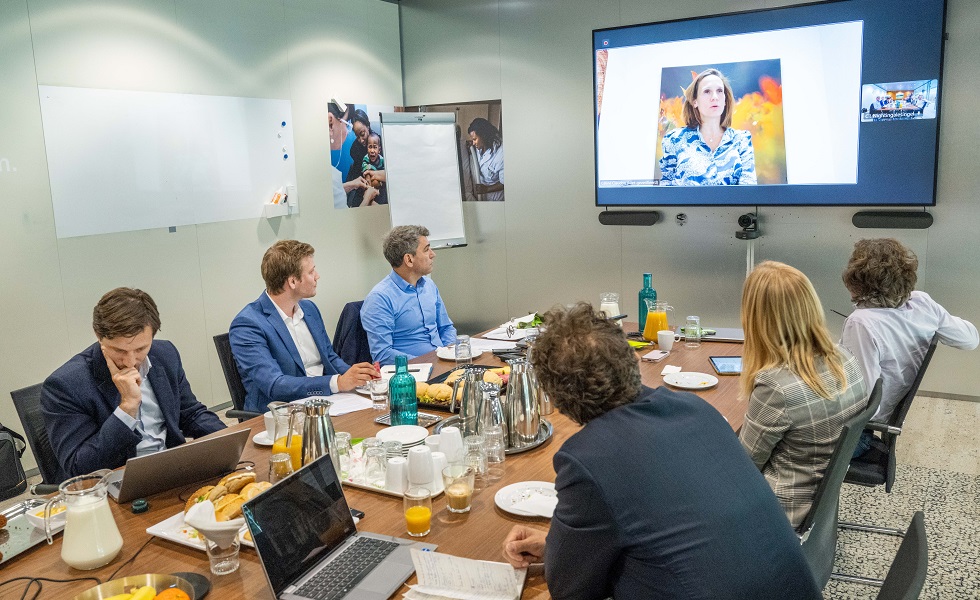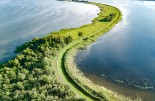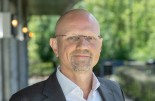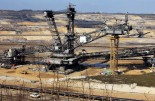Sustainable investing with Natural Capital (Roundtable Natural Capital - part 2)
Sustainable investing with Natural Capital (Roundtable Natural Capital - part 2)

This report was originally written in Dutch. This is an English translation.
Natural capital is a stable factor in the investment portfolio. The relatively high returns and low risks contribute to a high Sharpe ratio. Investors really need to commit to natural capital for the long term. That was the conclusion reached by six experts led by Sanne van Gorp of PGGM during the Round Table on Natural Capital. This is part 2 of the discussion.
By Hans Amesz
This is part 2 of the report. Part 1 can be read here, part 3 will be published on Monday 21 July.
|
Moderator Sanne van Gorp, PGGM
Participants Céline Claudon, IWC (meerderheidsbezit van BNP Paribas Asset Management) Jérôme Dulong, AXA IM Alts Sébastien Duquet, Mirova (onderdeel van Natixis Investment Managers) Arnold Gast, Morningstar Sustainalytics Ralf Kooken, a.s.r. real assets investment partners Mark de Nooij, MN |
What role does natural capital play in an investment portfolio and the portfolio construction process?
Kooken: 'Natural capital is a stable factor in the investment portfolio. The relatively high returns and low risks contribute to high Sharpe ratios. The various niches within this asset class each have their own characteristics and therefore offer diversification benefits. If a client prefers stable cash flows, for example, we recommend a higher allocation to agricultural land with annual crops such as soy and corn. And of course, it's also about contributing to biodiversity and sustainability, and about the low or even negative carbon footprint of both agriculture and forestry.'
De Nooij: 'Investors really need to take a long-term view of natural capital. A forest rotation can take twenty, thirty or even fifty years. Implementing sustainable forest management takes time, and only then can you really make an impact.'
Claudon: 'Many investors start with closed-end funds and then switch to separate accounts or evergreen structures. But it remains a long-term asset. That long investment horizon is a challenge, as is the question of where natural capital fits into your asset allocation. It remains a niche for many investors. A lot of education is still needed. You also need to agree with investors on the risk profile and impact goal they are pursuing. Some opt for sustainable forestry in developed core markets with low risk, others for reforestation in emerging markets. These are completely different investment profiles.'
Duquet: 'Pension funds indicate that their cash management sometimes makes it difficult to invest in natural capital. Solvency requirements also pose a risk. Not all insurers have the tools and risk indicators to properly assess these investments. And within a fund, it is difficult to combine all the wishes of investors. Some want forestry, others prefer regenerative agriculture or the circular economy. This makes structuring a fund complex. With carbon credits, you have to pay close attention to whether companies are really reducing emissions or just want to offset them. We only accept companies with a clear net-zero strategy. Otherwise, it encourages greenwashing.'
What are the advantages of a blended finance structure for financing natural capital solutions?
Duquet: 'A junior tranche from, for example, governments or funds offers protection to private investors. This allows us to finance projects in high-risk countries such as Ivory Coast, Ghana and Bhutan. But a junior tranche is difficult to find. It often takes more than a year to secure one.'
Claudon: 'We have little experience with blended finance. Most parties that approach us are unable to provide the junior tranche. We mainly invest in ordinary equity structures.'
Gast: 'For me, blended finance is not just about structures, but also about bringing worlds together. DFIs have impact experience and data. Pension funds can learn from that. But collaboration requires you to step outside your comfort zone.'
Dulong: 'We have had positive experiences with blended finance at project level, for example with a reforestation project in the Brazilian Amazon (with Mombak). Once it proved viable, we were able to attract financing with a World Bank-supported outcome bond. This allows you to obtain concessional financing for impact projects, maximising the use of capital risk.'
Kooken: 'Blended finance can make some investments in frontier markets, for example, fit within the strategy of institutional investors because the risks are reduced. However, this often limits the upside potential somewhat.'
How can investments in natural capital be positioned within the sustainable finance landscape, and what is needed to support the investment decisions required for real-world impact?
Gast: 'I think the asset allocation approach is too restrictive in some respects. Everything has to fit into small boxes. And with blended finance, you also see a scaling-up problem: many of the projects we are talking about are difficult to scale up and therefore not interesting for some large pension funds. So scalability is a challenge, just as data and reporting are challenges.'
De Nooij: 'To achieve greater impact, you need more investors, and to attract more investors, you need higher returns. More value must be assigned to carbon credits or biodiversity credits, or other forms of credits. You need more data, and it must be understandable to everyone. There must be consensus on what the data means and how to value it.'
Claudon: 'Transparency and scientific accuracy are essential to convincingly demonstrate the ecological value and additionality of an investment. For me, that is crucial to scaling up this asset class.'
Duquet: 'Obtaining the right data and reports is a real challenge. The sector is enthusiastic, even passionate, but also prone to controversy: different indices, data, systems – for a non-specialist, it's overwhelming. The impact of solutions in the field of biodiversity and natural capital is often difficult to express in monetary terms. Until their real sustainable contribution to long-term economic development is fully recognised, the sector offers a reasonable financial return, which unfortunately is currently sometimes lower than that of some conventional sectors. Nevertheless, there is real upside potential, for example with regard to certification premiums or carbon credits.'
How do you determine the value of natural capital assets and which measurement methods or tools do you use?
Claudon: 'There is a difference between financial value and ecological value. For the financial side, there are all kinds of valuation standards, such as USPAP in the United States, and various valuation methodologies. For the ecological part, we define a number of KPIs for each asset that we want to monitor. We use various tools for this, such as EDNA sampling, camera traps, bioacoustics and visual inspections. We also use a lot of GIS and satellite imagery. We process all of this in our ESG reports. Within each mandate, we work with investors to determine which indicators to track and how exactly we will do that. Many things are still in development. With natural systems, it is always better to report over a longer period of time. We report annually, but look at the impact over five years in terms of results and trends.'
Gast: 'Our focus is on providing tools to investors to manage risk, monitor impact and apply it across their entire portfolio. We provide data through multiple products. One of our core products is “product involvement”: we identify what a company does, what products it supplies and what its activities are. This helps investors to select or exclude companies, or to engage with them in a targeted manner. We also assess what companies are doing in terms of management and policy – for example, with regard to land use – and whether these are strong policies. One of our biggest challenges is to do this not only across portfolios, but also deeper into the supply chain. How deep do you go into the chain? How far do you go in reporting or holding companies accountable for what happens upstream? Ultimately, we want carbon investors to be able to properly fulfil their due diligence responsibilities.'
Dulong: 'For us, the key concept in relation to investment value is materiality, both financially and in terms of impact. What really constitutes a high-quality, ethical project? We look at a number of criteria, but one stands out as the most critical: the greenhouse gas integrity of the project, in particular whether the investment is truly additional. In other words, would the project not take place or even be harmful without our investment? To answer this question, we collect all kinds of data using geospatial analysis, LIDAR sensors, and so on. We are constantly improving our data capacity because we need to be sure that the impact is real and that there is no 'leakage'. An example of 'leakage' is when you restore a piece of forest, while a few hectares further on everything is being cut down. In that case, your net impact could be zero. That is why we monitor not only the project itself, but also the surrounding area. And we ensure that everyone in the area benefits from the conservation, so that there are no conflicting incentives. We also check for double claims and guarantee the sustainability of the conservation. We have talked about funds lasting twelve or fifteen years, which is a long time for end investors, but for nature it is nothing. If you really want to make an impact, it has to last at least fifty or a hundred years. From the outset, we take into account changes in land use, for example through conservation easements, legally binding agreements to ensure that the land remains protected after divestment. Sometimes we return the land to local communities with clear incentives for conservation, sometimes to governments. All of this must be properly arranged from the outset, otherwise your entire investment will disappear as soon as you exit and will therefore have had no lasting value. Because we have a large research team, we are able to thoroughly analyse the integrity and impact of our investments. We collect all the data ourselves, ensure transparent reporting to our investors, and do so on the basis of twelve core impact KPIs. These are inspired by the IFC Performance Standards, but are not exactly the same, because our project developers often find it difficult to apply these comprehensive standards in full. That is why we have created a practical translation that is better suited to the reality on the ground.'
|
Sanne van Gorp Sanne van Gorp works as an Investment Strategist in PGGM's Strategy Department. In her role, she advises PFZW on the fund's sustainable investment policy, drawing on her academic background in both finance and sustainability. She is working on the development of PFZW and PGGM's new impact strategy, which actively focuses on real-world impact. |
|
Céline Claudon Céline Claudon is Chief Commercial Officer at International Woodland Company (IWC), a specialist in natural capital. She has 20 years of experience in investing in natural capital, including evaluating portfolio managers for IWC's institutional clients. BNP Paribas Asset Management has a majority stake in IWC. |
|
Jérôme Dulong Jérôme Dulong is Head of Natural Capital Investments at AXA IM Alts and focuses on nature-based solutions and forestry. He is primarily responsible for the deployment of the AXA IM Natural Capital Fund, which was established with a $500 million investment by the AXA Group and invests globally in nature conservation and restoration projects. |
|
Sébastien Duquet Sébastien Duquet is Head of DFI & Sovereign Business at Mirova (part of Natixis Investment Managers). He develops private funds for development finance institutions and foundations, with a focus on energy transition and natural capital. Previously, he was CIO at Symbiotics. Duquet has also led Oxus and PlaNIS. He is co-founder of FinanCités and Planet Guarantee and has worked at Arthur Andersen and EY. |
|
Arnold Gast Arnold Gast joined Morningstar Sustainalytics in 2022, where he currently leads the ESG Sector Research team. This team consists of approximately 90 research analysts who provide company-level ESG ratings that assess risks, controversies and climate change impact. Previously, Gast worked at Shell Pensioenbureau Nederland, ILX, ACTIAM and Delta Lloyd Asset Management, among others. |
|
Ralf Kooken Ralf Kooken focuses on global infrastructure and natural capital investments in which a.s.r. real assets investment partners invest on behalf of its clients. He develops investment strategies and is responsible for the implementation and management of these investments. Kooken has extensive experience, both in the Netherlands and internationally, and is skilled in developing sustainable investment strategies, formulating net-zero policies and conducting climate scenario analyses. |
|
Mark de Nooij Mark de Nooij has an educational background ranging from Electrical Engineering at Delft University of Technology to General Management at Nijenrode Business University. He began his professional journey as an Engineer at Wartsila, followed by a move to MN, where he started working as an Investment Strategist. At NZ-Funds in New Zealand, he flourished as a Portfolio Manager. He has been back at MN since 2012. |

















